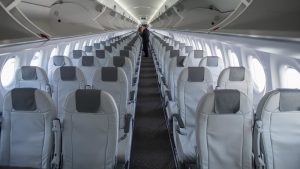Flying can be stressful, painful, or simply impossible for wheelchair users. Critics say it doesn’t have to be that way.

WHEN SHANE BURCAW flies on an airplane, he brings along a customized gel cushion, a car seat, and about 10 pieces of memory foam. The whole arsenal costs around $1,000, but for Burcaw it’s a necessity.
The 27-year-old author and speaker — who, alongside his fiancée, Hannah Aylward, is one half of the YouTube duo Squirmy and Grubs — has spinal muscular atrophy, a genetic disorder that affects motor neurons and causes muscle wasting and weakness. The disorder contorted his limbs and he has used a wheelchair for mobility since he was 2 years old. Today, he uses a motorized wheelchair custom-fitted to his diminutive, 65-lb. frame, but to board an airplane, he’s required to give it up. Instead, Aylward must carry Burcaw onto the plane, and from there, transfer him into a child’s car seat, which provides limited support and does not fit his body (thus, the foam).
“When you hear about the injuries and the discomfort and the embarrassment that wheelchair users have faced when flying,” Burcaw said, “it becomes pretty obvious that they’re not being treated in a very humane way with these rules.”
Indeed, regulations prohibit passengers from sitting in their own wheelchairs on planes, and, as a result, 29 years after the passage of the Americans with Disabilities Act (ADA), which dramatically increased American wheelchair users’ access to buses, trains, and other essential 21st century infrastructure, airplanes remain stubbornly inaccessible. For many wheelchair users, the experience of flying is stressful, painful, and sometimes humiliating. For some, it is simply impossible.
Emily Ladau, a disability rights activist, writer, and public speaker, does deep-breathing exercises to manage her anxiety as airport staff take her wheelchair away. She likens the experience to watching someone walk off with her legs. Things aren’t much better onboard. “Airplane seats are designed for the quote-unquote average person,” Ladau said. “I’m nowhere near the quote-unquote average person.” At 4’6”, she does not fit the seat easily. Her legs dangle. She cannot align her posture. “It’s very uncomfortable,” she said.
Read the full article here: https://undark.org/2019/12/03/making-flying-safe-accessible/?fbclid=IwAR12anC3a_5uwrH1MBh9q4wRUi6txearETo1yedwgZBm4LGfTmO079kf9vA

